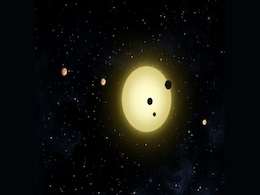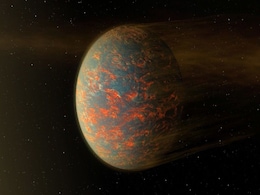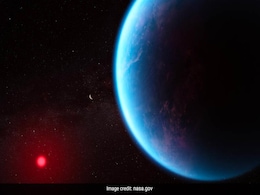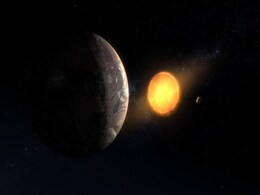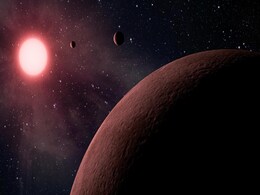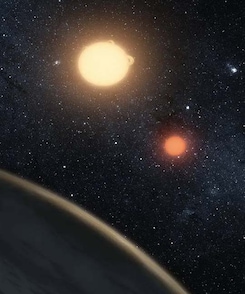Planet Kepler
- All
- News
- Web Stories
-

Kepler and TESS Discoveries Help Astronomers Confirm Over 6,000 Exoplanets Orbiting Other Stars
- Saturday December 13, 2025
More than 6,000 exoplanets (planets orbiting other stars), one of the most rapidly expanding frontiers in science, have now been confirmed by astronomers. Their search of other worlds has been transformed within a span of thirty years, which started as a form of speculation, to accurate detection. However, in the midst of this wave of discoveries, ...
-
 www.gadgets360.com
www.gadgets360.com
-

Exoplanets Explained: How Astronomers Find Worlds Orbiting Stars Beyond the Sun
- Monday September 8, 2025
Exoplanets are planets orbiting stars outside our solar system, hidden by stellar glare and detected indirectly. Astronomers identify them by tracking star wobbles or dips in brightness during planetary transits. NASA’s Kepler mission revealed thousands, with TESS now expanding the search. These discoveries confirm that planetary systems are abun...
-
 www.gadgets360.com
www.gadgets360.com
-

NASA Missions Uncover a Diverse Galaxy of Super-Earths, Raising New Questions About Planetary Evolution
- Thursday August 14, 2025
Super-Earths are among the most common planets in the galaxy, yet none exist in our solar system. Larger than Earth but smaller than Neptune, they range from ocean-covered worlds to scorched, atmosphere-less rocks. Some orbit within habitable zones, making them prime candidates for life. NASA’s Kepler and TESS missions, along with upcoming telesc...
-
 www.gadgets360.com
www.gadgets360.com
-

A Third of Milky Way’s Planets Orbiting Most Common Stars Could Hold Water, Harbour Life: Study
- Tuesday May 30, 2023
- Press Trust of India
One-third of the planets orbiting the most common stars across the Milky Way galaxy may hold onto liquid water and possibly harbour life, according to a study based on latest telescope data.
-
 www.gadgets360.com
www.gadgets360.com
-

Scientists Find 'Largest Cluster' of Nearly 100 Free-Floating Planets in a Single Star-Forming Region
- Monday December 27, 2021
- Edited by Gadgets 360 Newsdesk
Rogue planets have baffled astronomers for ages. Unlike regular planets which revolve around stars, these free-floating planets (FFPs) get ejected from star systems to move about in the galaxy on their own. In the latest discovery, astronomers found the largest cluster of rogue planets in a single star-forming region.
-
 www.gadgets360.com
www.gadgets360.com
-

After NASA Adds 301 New Planets, New UCLA Algorithm Helps Find Another 366 Exoplanets
- Thursday November 25, 2021
- Edited by Gadgets 360 Newsdesk
Just a day after NASA scientists said that they have found 301 new exoplanets, astronomers at the University of California, Los Angeles (UCLA) have stated that they identified 366 new exoplanets using data from the Kepler space telescope.
-
 www.gadgets360.com
www.gadgets360.com
-

NASA's Kepler Data Adds 301 Planets, Thanks to Machine Learning
- Wednesday November 24, 2021
- Edited by Gadgets 360 Newsdesk
A new deep learning method has added a whopping 301 exoplanets to the total tally. These planets were added to the already validated 4,569 planets which are orbiting several distant stars. The additions were made with the help of a deep neural method called ExoMiner.
-
 www.gadgets360.com
www.gadgets360.com
-

NASA Uses New Technique to Find a Planet Which Orbits Around Two Different Stars
- Thursday November 11, 2021
- Edited by Gadgets 360 Newsdesk
NASA scientists have found evidence for a new transiting circumbinary planet. The term refers to any planet which orbits around two different stars. The evidence was received using an unprecedented technique.
-
 www.gadgets360.com
www.gadgets360.com
-

Earth-Like Exoplanet Found Orbiting a Sun-Like Star a Little Over 3,000 Light Years Away: Study
- Tuesday June 9, 2020
- Gadgets 360 Staff
Planet KOI-456.04' is thought to be similar to Earth for several reasons. It is said to have a similar distance between its sun - Kepler-160 - with an orbit that takes it 378 days to complete. It also thought to receive 93 percent as much light as Earth gets from the Sun.
-
 www.gadgets360.com
www.gadgets360.com
-

Exoplanet Closest to Earth in Temperature and Size Found, NASA Announces
- Thursday April 16, 2020
- Prabhakar Thakur
Kepler-1649c is situated 300 light-years away from the Earth and is most similar to Earth in size and estimated temperature, according to NASA. The planet was discovered by the scientists while going through old observations made by Kepler telescope.
-
 www.gadgets360.com
www.gadgets360.com
-

17 New Planets Including Habitable Earth-Sized World Discovered
- Saturday February 29, 2020
- Science | ANI
University of British Columbia (UBC) Astronomy Student Michelle Kunimoto has discovered 17 new planets, including a potentially habitable, Earth-sized world, by combing through data gathered by NASA's Kepler mission.
-
 www.ndtv.com
www.ndtv.com
-

NASA's Kepler Space Telescope Finds 17 New Exoplanets, Including an Earth-Sized World
- Friday February 28, 2020
- Indo-Asian News Service
Researchers have discovered 17 new planets, including a potentially habitable Earth-sized world, by combing through data gathered by NASA's Kepler mission.
-
 www.gadgets360.com
www.gadgets360.com
-

Sub-Neptune Sized Planet Validated Using Habitable-Zone Planet Finder
- Friday February 21, 2020
- Science | ANI
The Habitable-zone Planet Finder (HPF), an astronomical instrument has confirmed an object initially observed by the Kepler spacecraft is an exoplanet.
-
 www.ndtv.com
www.ndtv.com
-

Researchers Find New ‘Super-Puff’ Planets With Density Lesser Than Cotton Candy
- Tuesday December 31, 2019
- Nadeem Sarwar
Scientists have discovered three new super light planets that fall in the class ‘super-puffs’ and are situated in the Kepler 51 start system.
-
 www.gadgets360.com
www.gadgets360.com
-

Kepler and TESS Discoveries Help Astronomers Confirm Over 6,000 Exoplanets Orbiting Other Stars
- Saturday December 13, 2025
More than 6,000 exoplanets (planets orbiting other stars), one of the most rapidly expanding frontiers in science, have now been confirmed by astronomers. Their search of other worlds has been transformed within a span of thirty years, which started as a form of speculation, to accurate detection. However, in the midst of this wave of discoveries, ...
-
 www.gadgets360.com
www.gadgets360.com
-

Exoplanets Explained: How Astronomers Find Worlds Orbiting Stars Beyond the Sun
- Monday September 8, 2025
Exoplanets are planets orbiting stars outside our solar system, hidden by stellar glare and detected indirectly. Astronomers identify them by tracking star wobbles or dips in brightness during planetary transits. NASA’s Kepler mission revealed thousands, with TESS now expanding the search. These discoveries confirm that planetary systems are abun...
-
 www.gadgets360.com
www.gadgets360.com
-

NASA Missions Uncover a Diverse Galaxy of Super-Earths, Raising New Questions About Planetary Evolution
- Thursday August 14, 2025
Super-Earths are among the most common planets in the galaxy, yet none exist in our solar system. Larger than Earth but smaller than Neptune, they range from ocean-covered worlds to scorched, atmosphere-less rocks. Some orbit within habitable zones, making them prime candidates for life. NASA’s Kepler and TESS missions, along with upcoming telesc...
-
 www.gadgets360.com
www.gadgets360.com
-

A Third of Milky Way’s Planets Orbiting Most Common Stars Could Hold Water, Harbour Life: Study
- Tuesday May 30, 2023
- Press Trust of India
One-third of the planets orbiting the most common stars across the Milky Way galaxy may hold onto liquid water and possibly harbour life, according to a study based on latest telescope data.
-
 www.gadgets360.com
www.gadgets360.com
-

Scientists Find 'Largest Cluster' of Nearly 100 Free-Floating Planets in a Single Star-Forming Region
- Monday December 27, 2021
- Edited by Gadgets 360 Newsdesk
Rogue planets have baffled astronomers for ages. Unlike regular planets which revolve around stars, these free-floating planets (FFPs) get ejected from star systems to move about in the galaxy on their own. In the latest discovery, astronomers found the largest cluster of rogue planets in a single star-forming region.
-
 www.gadgets360.com
www.gadgets360.com
-

After NASA Adds 301 New Planets, New UCLA Algorithm Helps Find Another 366 Exoplanets
- Thursday November 25, 2021
- Edited by Gadgets 360 Newsdesk
Just a day after NASA scientists said that they have found 301 new exoplanets, astronomers at the University of California, Los Angeles (UCLA) have stated that they identified 366 new exoplanets using data from the Kepler space telescope.
-
 www.gadgets360.com
www.gadgets360.com
-

NASA's Kepler Data Adds 301 Planets, Thanks to Machine Learning
- Wednesday November 24, 2021
- Edited by Gadgets 360 Newsdesk
A new deep learning method has added a whopping 301 exoplanets to the total tally. These planets were added to the already validated 4,569 planets which are orbiting several distant stars. The additions were made with the help of a deep neural method called ExoMiner.
-
 www.gadgets360.com
www.gadgets360.com
-

NASA Uses New Technique to Find a Planet Which Orbits Around Two Different Stars
- Thursday November 11, 2021
- Edited by Gadgets 360 Newsdesk
NASA scientists have found evidence for a new transiting circumbinary planet. The term refers to any planet which orbits around two different stars. The evidence was received using an unprecedented technique.
-
 www.gadgets360.com
www.gadgets360.com
-

Earth-Like Exoplanet Found Orbiting a Sun-Like Star a Little Over 3,000 Light Years Away: Study
- Tuesday June 9, 2020
- Gadgets 360 Staff
Planet KOI-456.04' is thought to be similar to Earth for several reasons. It is said to have a similar distance between its sun - Kepler-160 - with an orbit that takes it 378 days to complete. It also thought to receive 93 percent as much light as Earth gets from the Sun.
-
 www.gadgets360.com
www.gadgets360.com
-

Exoplanet Closest to Earth in Temperature and Size Found, NASA Announces
- Thursday April 16, 2020
- Prabhakar Thakur
Kepler-1649c is situated 300 light-years away from the Earth and is most similar to Earth in size and estimated temperature, according to NASA. The planet was discovered by the scientists while going through old observations made by Kepler telescope.
-
 www.gadgets360.com
www.gadgets360.com
-

17 New Planets Including Habitable Earth-Sized World Discovered
- Saturday February 29, 2020
- Science | ANI
University of British Columbia (UBC) Astronomy Student Michelle Kunimoto has discovered 17 new planets, including a potentially habitable, Earth-sized world, by combing through data gathered by NASA's Kepler mission.
-
 www.ndtv.com
www.ndtv.com
-

NASA's Kepler Space Telescope Finds 17 New Exoplanets, Including an Earth-Sized World
- Friday February 28, 2020
- Indo-Asian News Service
Researchers have discovered 17 new planets, including a potentially habitable Earth-sized world, by combing through data gathered by NASA's Kepler mission.
-
 www.gadgets360.com
www.gadgets360.com
-

Sub-Neptune Sized Planet Validated Using Habitable-Zone Planet Finder
- Friday February 21, 2020
- Science | ANI
The Habitable-zone Planet Finder (HPF), an astronomical instrument has confirmed an object initially observed by the Kepler spacecraft is an exoplanet.
-
 www.ndtv.com
www.ndtv.com
-

Researchers Find New ‘Super-Puff’ Planets With Density Lesser Than Cotton Candy
- Tuesday December 31, 2019
- Nadeem Sarwar
Scientists have discovered three new super light planets that fall in the class ‘super-puffs’ and are situated in the Kepler 51 start system.
-
 www.gadgets360.com
www.gadgets360.com


